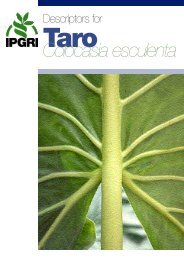Download PDF (6215 kb) - Bioversity International
Download PDF (6215 kb) - Bioversity International
Download PDF (6215 kb) - Bioversity International
Create successful ePaper yourself
Turn your PDF publications into a flip-book with our unique Google optimized e-Paper software.
The European Central Lathyrus spp. Database<br />
Manager: Daniel Combes<br />
IBEAS, University of Pau, France<br />
URL: http://www.univ-pau.fr<br />
EUROPEAN CENTRAL FORAGES DATABASES 31<br />
As mentioned in the last joint ECP/GR workshop in Budapest, the Lathyrus database in Pau<br />
contains about 4000 accessions. It includes four wild or semi-wild perennial species –<br />
L. heterophyllus, L. latifolius, L. sylvestris and L. tuberosus – and two annual species – L. sativus<br />
(grass pea), which is cultivated, and L. cicera, which is assumed to be one of the wild<br />
ancestors of L. sativus.<br />
The database was established in 1985 after a meeting on Lathyrus held in Pau. It is<br />
updated regularly (every year approximately). Countries of origin of the accessions are<br />
mostly European, but include North Africa, Middle East, Ethiopia and India. About 40<br />
countries are represented.<br />
Descriptors are the passport descriptors indicated by IPGRI. They have been modified as<br />
suggested in Budapest to provide information on genus (in Pau, until then, it did not seem<br />
useful, as only Lathyrus is concerned) and on species (until then we did not mention it, as the<br />
database is subdivided species by species). But as the objective is now a multicrop passport<br />
database, we completely agreed with this modification.<br />
The database has been recently enriched with data on Spanish accessions, kindly<br />
provided by Dr Isaura Martin (Madrid) after the Budapest meeting. The sofwares used in<br />
Pau are both FoxPro and Access. The database is freely available upon request, on floppy<br />
disk or paper.<br />
It is also freely accessible through Internet, on the Web site of the University of Pau (see<br />
above) pointing on 'Recherche' then on 'Biologie'. It is not yet really user-friendly, but in a<br />
few weeks it will be set under Oracle and so this drawback should be abolished. It is also<br />
accessible through Dirk Enneking's CLIMA site (Australia) with whom we are cooperating.<br />
One important point has not really been dealt with: looking for duplicates. In fact, as we<br />
are mostly working with wild species, real duplicates should be rare. A few populations<br />
from the Pau region (Pyrénées mountains) have been collected more than once (mostly<br />
twice) in different years. But, as they are natural cross-pollinated populations, the different<br />
samples are almost certainly genetically different, especially since population sizes are<br />
generally big (100 or more) and we have generally not paid attention to which individuals<br />
have been sampled. So the fact that different accessions have the same descriptors data does<br />
not mean that they are real duplicates and we may have difficulties in asserting it.




